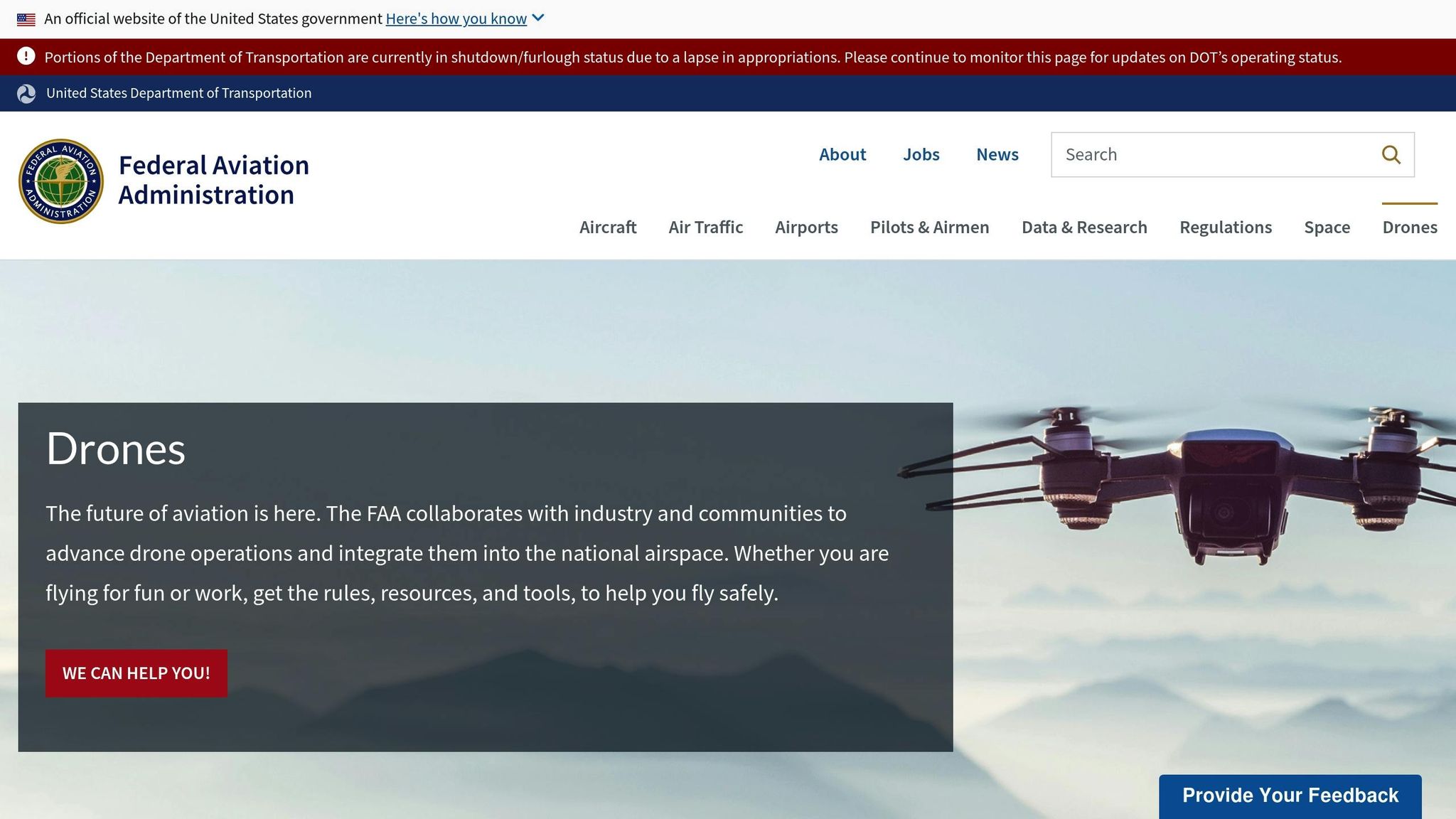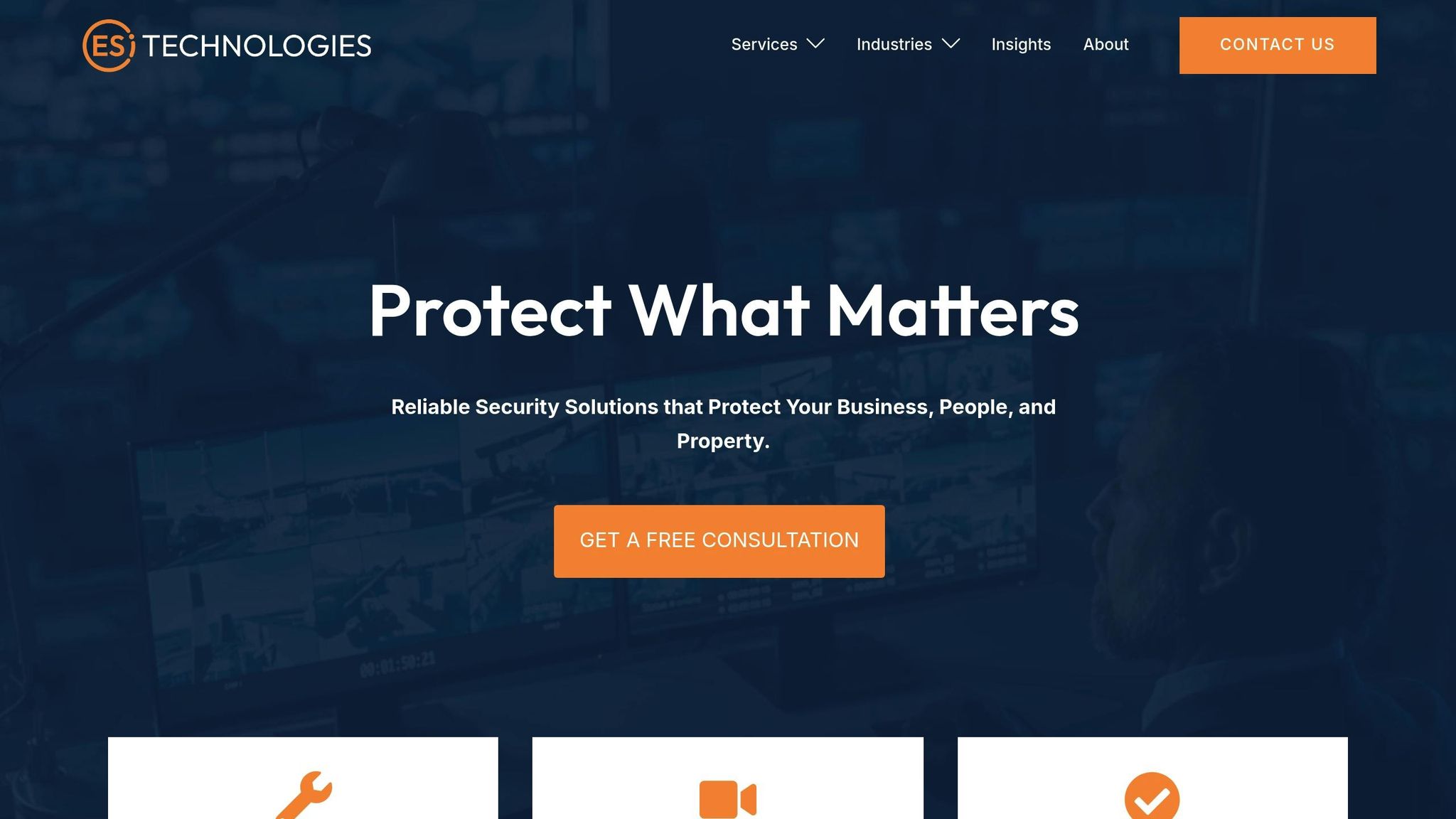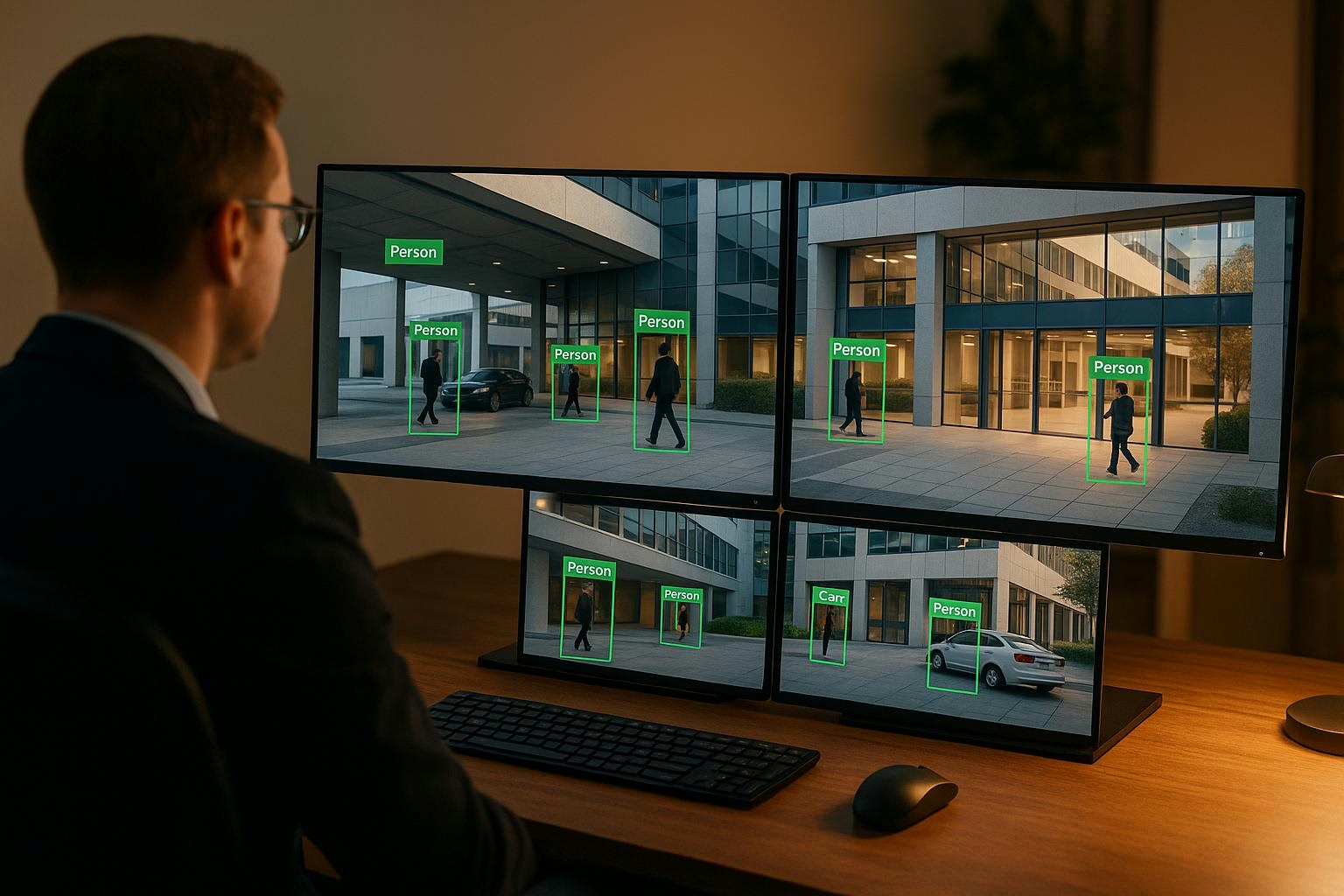AI object recognition is transforming commercial security by providing smarter, faster, and more accurate monitoring solutions. Here’s what you need to know:
- Why it’s needed: Businesses face challenges like theft, access breaches, and surveillance blind spots. Traditional systems often fail due to human fatigue, false alarms, and limited coverage.
- How it works: AI analyzes live video feeds, identifying and categorizing objects (e.g., people, vehicles) to detect threats in real time. It reduces false alarms and enhances response times.
- Key features:
- Real-time threat detection.
- Automated alerts for unusual activities (e.g., lingering, restricted access).
- Integration with drones for hard-to-cover areas.
- Cloud-based storage for secure data and trend analysis.
- Benefits: AI systems integrate with existing security setups, improve monitoring accuracy, and allow remote access through unified dashboards.
AI is reshaping security by addressing the shortcomings of older systems and providing businesses with 24/7, reliable protection.
Common Challenges in Commercial Security
Commercial properties face a range of security challenges that traditional systems often struggle to address effectively. These vulnerabilities can lead to significant financial and operational impacts.
Theft and Unauthorized Access
Theft and unauthorized access are among the most pressing threats for commercial properties in the United States. These incidents not only cause financial losses but also disrupt daily operations and jeopardize safety. According to the FBI, non-residential burglaries result in billions of dollars in losses every year across the country.
Certain industries are especially vulnerable. Automotive dealerships, for example, are frequent targets for organized theft rings due to their high-value inventory spread across large lots. Retail businesses face risks from both external theft and internal shrinkage, while logistics companies must safeguard valuable goods during transit and in storage facilities.
Unauthorized access poses additional dangers, such as compromising sensitive data, damaging equipment, and endangering employees. These breaches can lead to increased insurance premiums and even regulatory penalties if customer data is exposed.
At a commercial retail site in Kenner, Louisiana, ProVisual by APS detected an attempted theft when an unauthorized truck tried to steal scrap metal. The AI-powered system immediately identified the intruder, prompting a live operator to activate an audio warning and siren. The trespasser was instructed to leave, and the proactive response prevented any loss.
Cases like this highlight the growing sophistication of security threats and the limitations of traditional surveillance methods.
Limitations of Human Monitoring
Traditional security systems often rely heavily on human operators, but this approach has inherent weaknesses. Fatigue and distraction, especially during long or overnight shifts, can lead to lapses in attention. Security personnel tasked with monitoring multiple camera feeds for extended periods may miss subtle signs of suspicious activity or fail to respond quickly to real threats. Reviewing hours of footage after an incident can also result in overlooked details that are critical for investigations, turning what could have been a preventive measure into mere documentation.
These challenges demonstrate how human limitations can leave significant gaps in security coverage.
Coverage Gaps in Traditional Systems
Even well-planned traditional surveillance setups can fall short due to physical and technological limitations. Factors like restricted camera placement, narrow fields of view, and outdated equipment create blind spots that intruders can exploit. Areas such as loading docks, parking lots, and perimeters often lack adequate coverage, either due to budget constraints or installation challenges, leaving them vulnerable to unauthorized access or tampering.
Environmental conditions, such as poor lighting or adverse weather, can further hinder visibility or trigger false alarms. Additionally, traditional surveillance systems are typically reactive, providing evidence only after an incident has occurred rather than preventing it in real time. For businesses with multiple locations, managing disconnected camera systems and storage solutions adds another layer of complexity, often resulting in inconsistent security measures.
These limitations underscore the need for more advanced, proactive approaches to commercial security.
How AI Object Recognition Improves Commercial Security
AI object recognition technology brings a smarter approach to commercial security, offering systems that can detect and respond to threats more effectively. By addressing the limitations of traditional surveillance, these advanced tools improve both detection accuracy and response times, paving the way for enhanced security measures.
Real-Time Threat Detection
AI makes it possible to identify threats as they happen. With AI-powered surveillance, live video feeds are constantly monitored to spot suspicious activities instantly. These systems process data in just milliseconds, allowing security teams to act before incidents escalate into serious problems. For instance, AI can identify unauthorized access or unusual movements, triggering alerts to security personnel. Unlike human operators, AI maintains the same level of attentiveness 24/7, regardless of the time of day.
Automated Anomaly Detection
One standout feature of AI object recognition is its ability to learn what "normal" looks like for a specific environment – and flag anything that deviates from it. For example, if someone lingers near a loading dock for too long or enters a restricted area after hours, the system issues a targeted alert.
This automation picks up on subtle irregularities that might escape human notice. By analyzing multiple camera feeds at once, AI reduces false alarms by distinguishing real threats from harmless events, like animals wandering onto the property or debris blowing in the wind.
"Video verification helps reduce false alarms by allowing our monitoring team to visually confirm the presence of a real threat before contacting authorities. This not only speeds up response times in the case of a verified emergency but also prevents unnecessary disruptions from false alarms, saving time and resources." – ESI Technologies
Integration with Drones for Better Coverage
AI object recognition isn’t limited to fixed cameras – it also works seamlessly with drones to expand surveillance coverage. Equipped with AI, drones can monitor areas that are difficult or expensive to cover with traditional systems. This makes them ideal for large properties like warehouses, manufacturing plants, or multi-building facilities. They can patrol vast perimeters, detect intrusions, and provide a bird’s-eye view of hard-to-reach areas.
The combination of drone mobility and AI analysis creates a powerful security tool. Drones can follow pre-set routes or respond in real time to potential threats, capturing high-resolution images and delivering immediate assessments. This ensures even remote or challenging areas are fully protected, all while integrating smoothly into the broader commercial security framework.
Integrating AI Object Recognition with Existing Security Systems
AI object recognition shines brightest when it complements your current security setup. Instead of overhauling your entire system, it works with your existing cameras, access controls, and alarms, transforming them into a smarter, more responsive network.
Unified Monitoring for Better Control
Modern AI systems bring all your security components together into a single control center. From one dashboard, you can manage cameras, door locks, and alarms, giving security teams the ability to monitor multiple locations remotely, prioritize alerts, and assign varying access levels to employees.
By integrating AI with your existing cameras, the system can differentiate between people, animals, or debris, which significantly reduces false alarms. When an unusual activity is detected, the AI communicates with access controls and alarms to trigger the right response.
"Seamless integration with existing security infrastructure." – ESI Technologies
These systems also allow remote monitoring through mobile devices or computers, providing real-time access to live feeds, door controls, and alerts. This flexibility ensures security teams can act quickly, regardless of their location. The centralized control also integrates with cloud-based storage and advanced analytics for added functionality.
Cloud-Based Storage and Data Analysis
Cloud storage replaces the vulnerabilities of local systems with secure and scalable solutions. AI then processes this stored data to uncover patterns that human operators might miss. For example, it can identify peak times for security breaches, common entry points, or seasonal trends in threats. These insights help businesses make informed decisions about staffing, equipment placement, and security measures.
Video verification using cloud systems has proven especially effective at improving response times. When AI flags a potential threat, monitoring teams can instantly review high-quality footage to confirm the situation. This process can reduce police response times by up to 75% for verified threats, while also cutting down on unnecessary emergency calls.
Companies adopting these AI-integrated systems often report 30-50% savings on security costs compared to traditional staffing models, all while maintaining robust protection.
Compliance with FAA and U.S. Regulations

Integrating AI into security systems also requires strict compliance with FAA and U.S. regulations. For example, the Federal Aviation Administration (FAA) mandates Part 107 certification for commercial drone pilots. Operators must maintain a visual line-of-sight, adhere to altitude restrictions, and follow all established protocols. Detailed documentation of drone operations is essential to demonstrate compliance during inspections.
Another key regulation is NDAA compliance, which ensures security devices meet U.S. cybersecurity standards. As physical security systems become increasingly connected to business networks, using non-compliant devices can introduce vulnerabilities that jeopardize both physical and data security.
To stay ahead, businesses should conduct regular compliance audits. These audits review drone operations, ensure software is updated, and document system changes to maintain regulatory standards. Partnering with security providers familiar with these requirements can help businesses integrate AI smoothly while avoiding costly retrofits or penalties for non-compliance.
sbb-itb-ce552fe
How ESI Technologies Delivers Advanced Security Solutions

ESI Technologies is transforming the way businesses approach security by combining AI-powered object recognition with tools like surveillance systems, access control, fire alarms, audio-visual systems, and managed security services.
AI-Powered Surveillance Systems
ESI Technologies takes surveillance to the next level with AI-driven technology designed for precise threat detection. By using smart cameras and advanced analytics, their systems can instantly distinguish between people, vehicles, animals, and other objects. This means suspicious activities – like unauthorized access or lingering in restricted areas – are identified in real-time, while false alarms caused by harmless events are significantly reduced.
When a potential threat is detected, the AI system immediately notifies security personnel, allowing for quick action. Unlike older systems that depend on constant human oversight, these AI-powered solutions provide continuous monitoring without fatigue. Automated responses, such as triggering alarms or locking down areas, further enhance security.
"Yes, all of our technicians are fully licensed, certified, and experienced in installing and maintaining security systems. We ensure that our team stays up-to-date with the latest security technologies and best practices to deliver high-quality service to our clients." – ESI Technologies
Managed Security Services for 24/7 Protection
ESI Technologies also offers managed security services to provide round-the-clock protection. Their team of experts monitors systems 24/7, ensuring instant alerts and rapid responses. They take care of ongoing system maintenance, software updates, and technical support, keeping all devices running smoothly.
A real-world example from 2023 highlights the effectiveness of these services: at a retail site in Kenner, Louisiana, the system flagged an unauthorized truck. A live operator intervened immediately, preventing a potential theft. With mobile app integration, business owners and managers can monitor their properties and respond to incidents from anywhere, adding an extra layer of convenience.
Tailored Solutions for Industry-Specific Needs
Understanding that security challenges vary across industries, ESI Technologies customizes its solutions to meet specific needs. The company performs detailed risk assessments to address challenges unique to sectors like retail, healthcare, manufacturing, and hospitality. AI systems are fine-tuned to tackle industry-specific threats while ensuring compliance with relevant regulations.
These tailored solutions include strategic placement of cameras, customized AI analytics, and seamless integration with existing access control and alarm systems. Cloud-based storage and analytics provide secure and scalable options for retaining surveillance footage. Plus, AI-driven data analysis helps businesses identify trends, enabling smarter decisions about resource allocation and security investments.
The Future of Commercial Security with AI
Security is undergoing a transformation, and AI is at the forefront. With advanced object recognition, AI now enables proactive measures to stop incidents before they even happen. As businesses face increasingly complex threats, traditional security systems often fall short. This shift toward intelligent, proactive solutions is reshaping how commercial properties safeguard their assets and daily operations. Modern AI systems are designed to integrate smoothly with existing infrastructure, setting new standards for security protocols.
These AI-driven systems act quickly, triggering preventive actions while minimizing false alarms. They can analyze patterns, spot suspicious behaviors – like loitering or crossing restricted areas – and activate immediate responses such as audio alerts or automated lockdowns.
AI also ensures round-the-clock, efficient monitoring, eliminating the limitations of human fatigue and enhancing response times. By integrating with other systems, such as access control and fire alarms, AI creates a unified platform for comprehensive monitoring. Plus, cloud-based storage and analytics make managing security data more secure and scalable.
Why Choose ESI Technologies
As AI revolutionizes security, ESI Technologies transforms these advancements into practical, top-tier solutions. By combining cutting-edge AI with proven expertise, ESI delivers robust protection tailored to the needs of commercial properties.
Their systems are designed to grow with your business, making it easy to expand coverage to new locations or incorporate emerging technologies. With predictive analytics and automated response features, ESI helps clients stay ahead of potential threats while improving detection accuracy and operational efficiency.
FAQs
How does AI object recognition help reduce false alarms and speed up response times in commercial security?
AI object recognition is transforming commercial security by making threat detection more precise and reducing false alarms. This technology can differentiate between harmless movements – like a stray animal or weather changes – and real security risks, ensuring alerts are triggered only by credible threats.
With AI object recognition, monitoring teams gain the ability to visually confirm potential threats in real-time before involving authorities. This approach minimizes unnecessary disruptions while enabling quicker, more efficient responses to actual incidents, offering businesses stronger protection for their assets.
How does AI object recognition improve security systems and help prevent threats like theft or unauthorized access?
AI object recognition takes security systems to the next level by offering real-time monitoring and instant alerts for suspicious activities, like theft or unauthorized access. By processing live video feeds, AI can quickly detect unusual behavior or objects, allowing for faster responses and minimizing the chances of human error.
When paired with modern surveillance tools, AI-driven solutions deliver 24/7 protection and in-depth insights, helping businesses create a safer environment. These tools not only streamline security operations but also provide reassurance by tackling potential threats before they escalate.
How does AI object recognition improve surveillance by addressing coverage gaps and reducing the need for constant human monitoring?
AI-powered object recognition transforms surveillance by offering continuous, automated monitoring that fills coverage gaps and minimizes the need for constant human supervision. This advanced technology can identify objects or detect unusual activities in real time, enabling faster responses to potential threats.
When integrated into commercial security systems, AI object recognition provides businesses with round-the-clock monitoring, instant alerts, and heightened precision in spotting risks. This means better protection against theft, unauthorized access, and other security breaches – delivering a more dependable and proactive approach than traditional surveillance methods.

